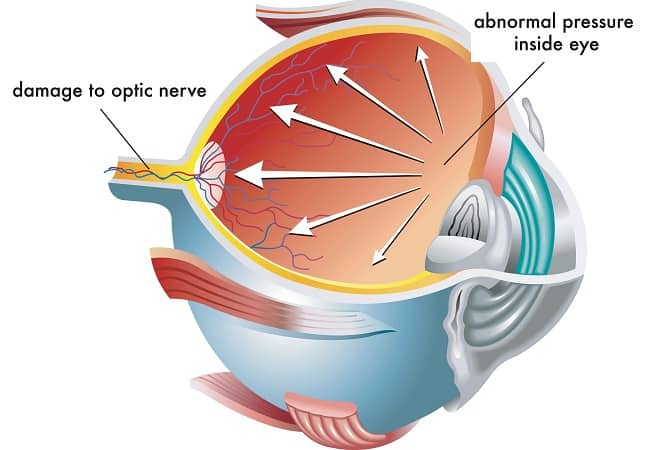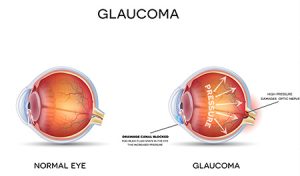
Glaucoma Treatment
For Clearwater & St. Petersburg, FL
Glaucoma, a condition that damages the eye’s optic nerve, is one of the leading causes of blindness for people over age 60. Because vision loss due to glaucoma can’t be recovered, it’s important to have regular eye exams that include measurements of your eye pressure. The earlier the diagnosis for glaucoma, the better the chance that vision loss can be prevented or slowed. As a general rule, the American Academy of Ophthalmology recommends having a complete eye exam every five to 10 years for people under age 40; every two to four years for those ages 40 to 54 years old, and every one to three years if you’re between ages 55 and 64.
In Largo, Florida, St. Michael’s Eye & Laser Institute provides comprehensive eye exams and effective treatment for glaucoma that can include surgery. As a family-owned and -operated eye-care clinic serving the Tampa Bay area, our goal is to ensure that our patients understand exactly what glaucoma is and how best to preserve their vision.

What Is Glaucoma? Causes Of Glaucoma
At the front of the eye, between the colored iris and the cornea—the eye’s clear protective outer layer—there is a small fluid-filled area called the anterior chamber. As with blood pressure, the pressure in this chamber—called intraocular pressure or IOP—should not be too elevated. Increased pressure is called glaucoma. When this pressure gets too high, irreversible damage to the optic nerve can occur, which can result in blindness.
In most cases, increased pressure results from the eye’s inability to drain fluids from the anterior chamber properly. Fluids are constantly flowing into the chamber and must be able to drain out where the cornea meets the iris at its outer edges. But when the eye’s drainage channels become clogged, glaucoma may develop. This is referred to as open-angle glaucoma, the most common form of the condition.
In acute angle-closure glaucoma, abnormalities in eye structures, such as a bulging iris, blocks drainage of the fluids.
Secondary glaucoma exists when there is another health condition triggering the drainage problem, such as diabetes, a tumor, or trauma. In this case, both the glaucoma and the primary condition must be treated.
Some children are born with congenital glaucoma, which results from abnormalities that developed as the eye formed.

Glaucoma Symptoms
Perhaps the most important aspect to know about glaucoma is that it often progresses painlessly. Unfortunately, by the time glaucoma symptoms appear, the optic nerve could be irreparably damaged. Still, it’s important to know that glaucoma symptoms include:
- Blurred vision
- Intense eye pain
- Glare around lights
- Nausea and vomiting
- Light sensitivity
How Is Glaucoma Detected & Diagnosed?
There are several tests that provide a complete picture of the eye’s health. To test for glaucoma eye disease, your doctor will visually examine the optic nerve and use a special device to examine the structures at the front of the eye to evaluate its ability to drain fluids properly. Your IOP will be tested along with your peripheral vision. Through regularly scheduled eye exams, your eye doctor can detect small changes that may be the first signs of glaucoma.
How Do You Treat Glaucoma?
The most common treatment is the use of eye drops to reduce IOP. Some people may need more than one type of medicated drops. If medication fails to reduce the IOP, laser treatment for glaucoma may be needed to improve the ability of the eye to drain fluids. The goal of this procedure is to improve the eye’s drainage channels.

Cost Of Glaucoma Treatment
Glaucoma is an incurable eye disease that often requires lifelong management to prevent blindness. Treatments can be costly. A 2014 article in Glaucoma Today reported the estimated direct cost of early glaucoma treatment was about $600 per year, with end-stage glaucoma treatments costing up to $2,500 annually.
The actual price of treating glaucoma depends on the type and on your geographic location. Our office offers financing options for our Tampa Bay area patients, and insurance may cover some costs. Glaucoma treatment is also eligible for Flexible Spending Accounts (FSA) and Health Savings Accounts (HSA).
Types Of Glaucoma
Glaucoma is a group of eye diseases that cause increased eye pressure and damage to the optic nerve. There are four primary glaucoma types, including:
Open-Angle Glaucoma
Open-angle glaucoma is the most common form of this eye disease in nine out of 10 patients. You may not experience any symptoms until vision loss occurs, and it typically affects peripheral (side) vision first. The cause of open-angle glaucoma is unknown and happens when pressure builds inside the eye and can’t drain fast enough, increasing pressure and leading to optic nerve damage. Open-angle glaucoma will eventually cause blindness, and high blood pressure and diabetes are high-risk factors for this form.
Normal-Tension Glaucoma
This type of open-angle glaucoma is more common in people of Japanese descent or with a family history of normal-tension glaucoma and in people with heart problems and low blood pressure.

Angle-Closure Glaucoma
Also called narrow-angle or acute glaucoma, this form is considered a medical emergency. It’s imperative to seek medical attention if you experience the sudden onset of intense eye pain, nausea, red eye(s) and blurry vision. Closed-angle glaucoma happens when the edge of the iris blocks fluid from flowing out from the eye, creating a quick spike in eye pressure that can cause blindness in mere days. Laser treatment and medicine are required to drain the excess fluid and lower intraocular pressure.
Congenital Glaucoma
One in 10,000 children may be born with this type of glaucoma that prevents fluid from draining out of the eye normally. Infants may have cloudy eyes, excess tear production, larger eye sizes and light sensitivity. Early surgical intervention can typically avoid permanent vision loss.
Secondary glaucoma may be the result of another condition and can require special treatment.
Glaucoma Treatment Options
Your glaucoma treatment will be unique to your circumstances and may include oral medicines, prescription eye drops, laser treatment, surgery or a combination of these options. Prescription eye drops are often the first treatment method for early glaucoma and work to decrease intraocular pressure and enhance drainage from the eye. Some eye drops may lower fluid production in the eye to manage eye pressure. You may be prescribed multiple eyedrops and oral medications for optimal management.
Selective Laser Trabeculoplasty
Selective laser trabeculoplasty (SLT) is a procedure for open-angle glaucoma and may be offered instead of eye drops or in combination with them. SLT is a relatively new glaucoma treatment that uses low-energy light in brief pulses to target the pigmented cells (cells that contain melanin) in the trabecular meshwork. The trabecular meshwork is a sponge-like tissue near the cornea that filters the fluid out of the eye and is the area of greatest resistance for drainage.
Minimally Invasive Glaucoma Surgeries (MIGS)
These are a group of procedures that are less invasive than traditional glaucoma surgeries and work to lower eye pressure and protect the optic nerve. MIGS mitigates many of the risks of standard glaucoma surgery and could be a good option for mild to moderate cases.
These procedures include microtrabeculectomy, trabecular surgery, suprachoroidal shunts and fluid-reduction surgeries. MIGS may not prevent the need for traditional glaucoma surgery later on but provides a surgical option for people who previously had to wait for the disease to progress to qualify for invasive treatment.
Laser Iridotomy
Laser iridotomy is the first-line treatment for angle-closure glaucoma. It’s used as a preventive measure for eyes at risk of vision loss from the sudden spike in intraocular pressure. The procedure creates a hole outside the iris to widen the drainage angle between the cornea and iris to expose the trabecular meshwork and restore proper drainage. Laser iridotomy can preserve your remaining vision and halt disease progression but does not work for all cases and may require further laser surgery and treatment.
Filtration Surgery
Filtration surgery is an option for open-angle and closed-angle glaucoma and can dramatically decrease eye pressure to save your remaining vision. The procedure makes a small channel to improve fluid outflow using microsurgical equipment. An opening in the sclera (white portion of the eye) allows fluid drainage to bypass the trabecular meshwork, and the hole is covered by a flap that controls outflow. The draining fluid collects in a small blister called a bleb and is absorbed by the blood vessels under the upper eyelid.
Filtration surgery has a high success rate, but some patients require additional surgery and treatment to maintain results or lower eye pressure even further.
Contact St. Michael’s Eye & Laser Institute
Since our founding in 1961, we have performed successful glaucoma surgery on thousands of patients with different forms of the condition. Our doctors are experts in laser treatment for glaucoma. Furthermore, our leading-edge use of vision technology has earned us an Alcon Center of Excellence award every year since our founding. For a new focus on life that includes comprehensive glaucoma prevention and treatment, contact St. Michael’s Eye & Laser Institute. We’re committed to offering the highest standard of patient care to our patients in Largo and other Tampa Bay communities.
Glaucoma FAQs
Can I go blind from glaucoma?

Will glaucoma treatment restore my vision?
Unfortunately, vision that has deteriorated from glaucoma cannot be revived with treatment. What glaucoma treatment is successful at is slowing or stopping the progression of glaucoma so that you can maintain more of your vision. That should be all the incentive you need to seek treatment as soon as you receive a glaucoma diagnosis. Even if glaucoma is not “curable,” you can avoid the worst consequences with prompt care.
I’m worried I may have glaucoma — how can I tell?
In early stages, glaucoma may not present discernable symptoms. In fact, nearly half of the 3 million Americans with glaucoma do not realize that they have the condition. Even when symptoms (such as peripheral vision loss, blind spots, and light halos) become more noticeable, many people attribute the problems to “aging” rather than a serious eye condition. The best way to know for sure whether you have glaucoma is to undergo regular eye examinations, which can catch the condition long before you notice it on your own.
What is the optic nerve?
Located at the back of the eye, the optic nerve has the important role of transporting messages from the retina (where the eye turns light into pictures) to the brain. When pressure in the eye increases, this usually damages the optic nerve. This disrupted communication between the brain and retina then downgrades the quality of your sight.
Will I temporarily lose my vision after glaucoma treatment?

How often will I need glaucoma treatment?
Ultimately, that depends largely on the type of glaucoma you have and the specific treatment(s) that you and your doctor decide on. While some patients schedule appointments a few times per year, others manage to stabilize their glaucoma and can schedule annual appointments. The key is to commit to a doctor-supervised treatment plan to ensure that you are not losing vision.
Is it possible to prevent glaucoma?
Because glaucoma is suspected to have a genetic link for many patients, there is no way to definitively prevent glaucoma. However, there are certainly research-backed steps you can take to reduce your risk for developing the condition. These include exercising regularly, eating a nutritious diet, keeping your weight and blood pressure at healthy levels, and not smoking. If you have an immediate family member with glaucoma, staying healthy is extra important to try to avoid raising your ocular pressure.
 Patient Portal
Patient Portal  Online Payment
Online Payment  Doctor Referral
Doctor Referral  Financing
Financing 

